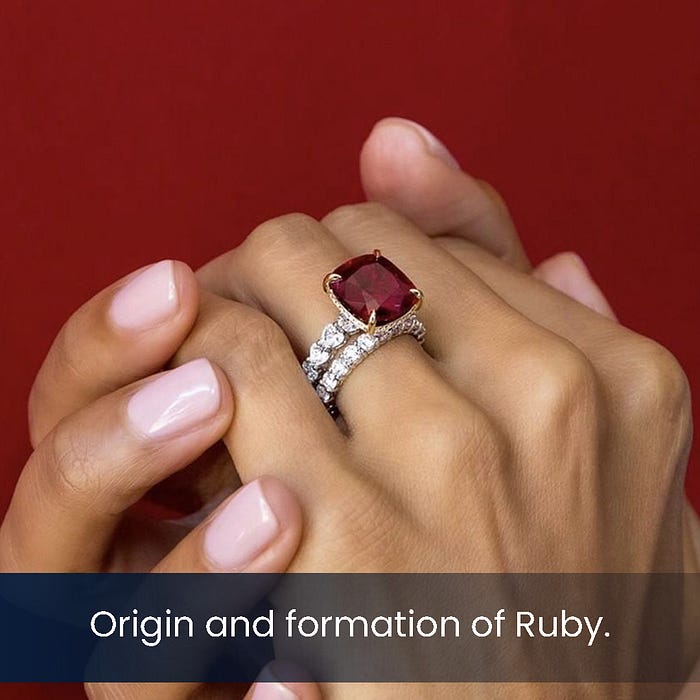Origin and formation of Ruby.

Nature provides us with various alluring things, but among them, one of the most beautiful possession of it are the gemstones. To keep us more fascinated, the gems come in different colors, compositions, and elegance. Gemstones have always been used to make different jewellery pieces since ancient times. Ring Designs made with various gemstones like diamond, ruby, moissanite, sapphire, emerald, and many other has always been in practice for multiple occasions and purposes. This article will deeply study the origin and formation of the beautiful red-colored gemstone ruby.
SOME INTERESTING FACTS ABOUT THE EXISTENCE OF RUBY:
Like any other gemstone, rubies are also formed in the natural process under the earth’s crust. The formation of rubies requires a specific natural condition; maybe that makes them one of the world’s most precious and beautiful gemstones.
Rubies are made from minerals known as aluminum oxide or corundum, just like diamonds come from the mineral carbon. The formation of ruby is very interesting as, under natural circumstances, it attains the beautiful red color. They are formed when rubies go through extreme heat and pressure under the earth’s surface. The mineral corundum is the result of densely packed aluminum atoms and oxygen. So generally, these are all colorless substances, but in exceptional conditions, when these aluminum atoms get replaced by other minerals or substances, then the stone might take any different color; maybe that is the reason why the color of ruby is red as other minerals take the place of the aluminum atoms.
The presence of chromium is mainly responsible for the deep red hue color of the gemstone ruby. Rubies can also come in other colors, which are quite rare. In that case, the presence of other minerals makes it a bit different from the typical red hue, like the occasional orange and pink shades of ruby are created when there is a presence of chromium and ferric iron. Even if chromium atoms replace 1% of the aluminium atoms, the ruby gets a deep red color. Nature never fails to keep us amazed with its creation.
But one thing that can never go unnoticed is that, like other gemstones, diamonds, sapphire, and all, rubies are quite rare for two reasons. The first reason is that the presence of iron or silica prevents the formation of ruby. On the other side, the corundum is also a very rare mineral(required for the formation of the ruby). So all these conditions combined are responsible for the gemstone ruby to be found easily. Due to its rarity, the prices of rubies also go high. The custom engagement rings can also be made with ruby if one wants to follow a bit different trend going out of the traditional styles of always opting for diamonds for the ring designs.
Rubies are also created in the labs. Most naturally formed rubies have imperfections while developing or forming under the earth’s crust. These conditions or characteristics responsible for the formation of ruby are known or referred to as rutile needs or silk. Therefore a naturally formed ruby under the earth’s crust is quite different from lab-grown ones.
Rubies are found in different regions all over the world. The main ruby deposits are generally in Asian countries like India, Thailand, Nepal, Pakistan, and Myanmar. The reason for these places to have the formation of ruby in abundance is because the tremendous heat and pressure that is required for the formation of ruby are here in these areas. In India, rubies are found along the stretch of land that forms the border of the magnificent Himalayan mountain range. The Indian subcontinent and the continents of Asia collided with each other, which resulted in tremendous pressure. At the same time, the presence of some minerals (required for rubies to form) has made it possible to develop ruby in quite a huge amount in these areas. Other places where ruby deposits are found are Madagascar, Montana, and Macedonia. The formation of ruby is believed to have dated back to 50 million years ago.
As stated earlier in this article, rubies come in different color variations. They are also found in other regions, but among all the ruby deposits in Myanmar (known as Burma), they persist as the most striking collection of ruby. Ruby deposits are found worldwide, but the deposit of Myanmar or the Burmese ruby is categorised separately because of its rich red color. The gemstone ruby is also considered the July birthstone.
CONCLUSION:
For more than two thousand years, rubies India was regarded as Ruby’s country as it was found in abundance here. But recently, countries like Sri Lanka, Pakistan, and Afghanistan have come up with substantial deposits of the gemstone Ruby. Southeast Asia, Thailand, Vietnam, and Cambodia are other places deemed to have good sources of rubies.
